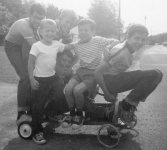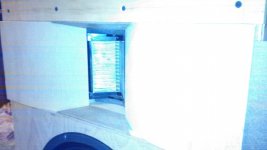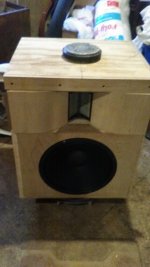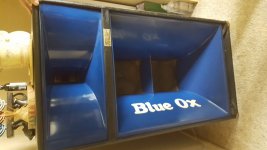Sadly true.engineering schools don't teach blueprints/mechanical drawing anymore because it's all CAD/CAM based.
My Son is studying Industrial Engineering and I am appalled at the lows teaching quality has fallen.
Terrible to say so but he and his fellow students "know nothing"
Oh, they can recite the mumbo jumbo and pass exams (which require just that) and he´ll eventually get a degree but none can work at a factory, except in Administrative jobs.
Not hereYou could always tell someone was a mechanical engineer by his/her writing.
*Calculators?*The engineering students carried T-squares and calculators attached to their belts
You guys had it easy
We carried slide rules: large , small and circular, I still can use my large Staedtler.
Got my first calculator, a Bowmar, at second or third year of Engineering, and had to ask an Air Hostess to buy one in New York for me.
You crazy AmericansWore t-shirts that said "Yesterday, I didn't know how to spell engineer and today I are one."
We were split in 2 groups according to University background.
Us students at the "high class" one were as square as floor tiles, always in a 2 or 3 piece suit, short hair combed with hair fixer, the works.
Those at the Public University, in those revolutionary turmoil years, dressed like Che Guevara, beard included, kicked teachers from stage shouting "this class is taken in the name of The People" and in general made a mess of Studies.
Oh well.
You bet.For some reason, I really enjoy the stuff I make more than anything I can buy.
I make stuff even if it´s commercially available.
Including non Electronic (ummmmm ..... "mechanical" stuff, I wonder why
Even making an LM3886/TDA7294/TDA1514 discrete replacement, go figure.
Have been burnt before with obsolete ICs, currently burnt by TDA2050 disappeareance, my discrete version takes longer to assemble, obvious, but costs less (remember "everything here costs twice as in USA"), can be adapted to use "whatever´s available" and will be repairable, at component level, 20/30 years into the future.
I went to university in the mid-1980s, my youngest son took AP Calculus in high school. (Graduated 2012. I was 35 when he was born). The teacher showed them how to use Wolfram Alpha website to check their answers. They could also post questions on a Facebook page the teacher set up.
That was the most difficult part about Calculus I for me- I didn't know if the answer was even close until I went back to class.
I'm working part time at a university and have students come to the laboratory I manage, asking if they can work there. I usually hand them a drill and drill bit, ask them to put the drill in the chuck. Nine times out of ten, they don't know how to do that. I've had students come in and want to drill a hole, heard them saying to each other that it's not working and saw the drill was running counterclockwise.
There are also students who have worked in their parent's business who are almost journeyman machinists and everything in between. Those are the students who join the design teams, making race cars, robots, airplanes, medical devices, etc. Gives me faith in the next generations.
That was the most difficult part about Calculus I for me- I didn't know if the answer was even close until I went back to class.
I'm working part time at a university and have students come to the laboratory I manage, asking if they can work there. I usually hand them a drill and drill bit, ask them to put the drill in the chuck. Nine times out of ten, they don't know how to do that. I've had students come in and want to drill a hole, heard them saying to each other that it's not working and saw the drill was running counterclockwise.
There are also students who have worked in their parent's business who are almost journeyman machinists and everything in between. Those are the students who join the design teams, making race cars, robots, airplanes, medical devices, etc. Gives me faith in the next generations.
EliGuy,
The transition from "snap" to "firecracker" and "shimmer" to "crash" sounds almost exactly how I'd describe the level difference listening to a live drum kit moving from a few meters to about 6 meters, about twice as loud, or a 10dB difference, similar to the sensitivity difference between a typical compression driver/horn combination and the upper output of a 424 morel/waveguide.
Have you ever tried comparing a compression driver/horn combination on one side balanced in level to your 424 morel/waveguide?
Art
Weltersys,
I have compared decibel for decibel, and I really really wanted the CD's to sound good because
I'm working on my own speaker design with a 20" waveguide. I was hoping to get everything from
800hz up with the CD but of course ran into issues with beaming. But even using the B&C de250 from 1500hz up I was never fully satisfied with it. Accurate, yes it was. But as someone else mentioned here there was a stress it put on my ears. Im not discounting the possibility of something else Ive over looked, such as waveguide design. Its just my experience so far. I prefer the softer sound of the dome tweet. I dont like the word 'smooth' because I always felt that the CD was smooth but there was always this attack where it suddenly felt too loud like a hammerdrill on my eardrums.
The other issue is I dont feel that CD's do well in the mid zone. Then you run into the issue of c2c distance using a waveguide. I suppose you could do a tapped horn though, I havent tried that yet. But using a concentric 2 way solves the problem well enough for me. Its not perfectly smooth directivity on the polars like a cd would be, but Im a firm believer in getting 80% of the way perfect is usually good enough.
Weltersys,
I prefer the softer sound of the dome tweet. I dont like the word 'smooth' because I always felt that the CD was smooth but there was always this attack where it suddenly felt too loud like a hammerdrill on my eardrums.
The other issue is I dont feel that CD's do well in the mid zone.
I believe the largest elephant in the room is still personal preference. Nothing wrong with sticking with what one actually likes. I've met plenty of people who live and die by XYZ, be it CD's, planars, ribbons, paper cones, Berylium, electrostat, open baffle, etc, etc.
I like good compression drivers in largish horns for that "live" sound, which I think largely stems from the very high sensitivity that allows low-level microdynamics and contrast to come through more effortlessly.
The Devil with CD's is how to cover frequencies above and below CD. 2" CD's often require the complexity of another tweeter on top, and 1" CD's never go down low enough. When experimenting with 1" CD's, I found a large difference in midrange satisfaction by reaching down a few hundred Hz more, which requires larger horn support and steep slopes. One also has to choose the low-midrange/bass driver carefully that is efficient, fast enough to keep up, but large enough to give decent bass extension.
Even then, true satisfaction did not come without a really good tube amp on the CD, so

I use a modular 3 way so I can change easily between MF/HF domes and horns. All are EQ flattish and phase corrected and they sound good but also different. The horns seem to have more detail and depth and sound more lively. I cross a 1" poly CD at 725Hz with a large horn but it requires alot more EQ effort than the done/cones. It would be impossible (for me anyways) to get it right without measurements.
EliGuy,
There is no such thing as a perfect driver or audio system ( or much of anything else in life) so you have to make choices on what sounds please your ears. I have had several experienced musicians over to listen to my audio system, the most common comment made is "it sounds as close to my instrument as I have ever heard". This is from recordings professionally made for them--their sound reference. The drummers are very critical about the "snap" on a snare and the ring / decay on their cymbals. Since I belong to two audio clubs in the NYC area, about 250 members plus other non members, I have heard many systems, some excellent, some mega-buck systems that are not so good. IMHO, horns can realistically reproduce the power, scale, dynamics, clarity and detail great recordings have better then anything else I have heard. Are they perfect, NO, nothing is. Sometimes, instruments sound hard because they can be, a vicious wack on a drum or cymbal crash WILL sound hard and annoying to some--because it is !! PROPER horn speakers have the ability to bring that effect to your ears and not round off the edges. It is not the compression drivers fault. Just my .02 cents !!
Just for the fun of it, see if your speakers can realistically reproduce the snap of drums and cymbal crashes on this CD. I skip the 1st track--just too much, even for me !! Tracks 8, 10, 15 are an excellent reference.
https://www.amazon.com/Knock-Out-2000-Charly-Antolini/dp/B00002DECO
Another good, live, compilation CD is Th VH1 Storytellers sampler
VH1 Storytellers CD (2000) 606949051129 | eBay.
The Live VH1 Storytellers CD ---Johnny Cash and Willie Nelson is also excellent.
Happy listening and HAPPY THANKSGIVING to all !!
Joe
There is no such thing as a perfect driver or audio system ( or much of anything else in life) so you have to make choices on what sounds please your ears. I have had several experienced musicians over to listen to my audio system, the most common comment made is "it sounds as close to my instrument as I have ever heard". This is from recordings professionally made for them--their sound reference. The drummers are very critical about the "snap" on a snare and the ring / decay on their cymbals. Since I belong to two audio clubs in the NYC area, about 250 members plus other non members, I have heard many systems, some excellent, some mega-buck systems that are not so good. IMHO, horns can realistically reproduce the power, scale, dynamics, clarity and detail great recordings have better then anything else I have heard. Are they perfect, NO, nothing is. Sometimes, instruments sound hard because they can be, a vicious wack on a drum or cymbal crash WILL sound hard and annoying to some--because it is !! PROPER horn speakers have the ability to bring that effect to your ears and not round off the edges. It is not the compression drivers fault. Just my .02 cents !!
Just for the fun of it, see if your speakers can realistically reproduce the snap of drums and cymbal crashes on this CD. I skip the 1st track--just too much, even for me !! Tracks 8, 10, 15 are an excellent reference.
https://www.amazon.com/Knock-Out-2000-Charly-Antolini/dp/B00002DECO
Another good, live, compilation CD is Th VH1 Storytellers sampler
VH1 Storytellers CD (2000) 606949051129 | eBay.
The Live VH1 Storytellers CD ---Johnny Cash and Willie Nelson is also excellent.
Happy listening and HAPPY THANKSGIVING to all !!
Joe
I have compared decibel for decibel, and I really really wanted the CD's to sound good
As asked before: you have any measurements to compare? On and off axis measurements should give some pointers.
I'm very fortunate the have had a father with a basement shop where he'd use tools in front of me, and I'd watch him make me things. (He was a ME) As a result, I know how to tighten a chuck with a key and when the drill is spinning backwards...I saw that one happen to a young lady in the lab, giving the boys a good chuckle.
The kart all the kids are piled on - I remember when he got the parts kit - you supplied the wood. I'm driving. Eventually, we put a gas engine on it, with the toothed-wheel drive from an old rototiller. It went pretty good - until the kid (in front) gave it a forward shove and then it threw a rod. My father fixed that too - with epoxy.
When you see various stuff done throughout your formative years, that's the college of a fortunate life. He gave me an opportunity to get an EE and while I rarely used the majority of what I learned in school - I used what I learned from my father all the time. People in my workplace would ask "how do you know what to do?" when I'd take this, that and some other thing, put them together and make up some solution.
The kart all the kids are piled on - I remember when he got the parts kit - you supplied the wood. I'm driving. Eventually, we put a gas engine on it, with the toothed-wheel drive from an old rototiller. It went pretty good - until the kid (in front) gave it a forward shove and then it threw a rod. My father fixed that too - with epoxy.
When you see various stuff done throughout your formative years, that's the college of a fortunate life. He gave me an opportunity to get an EE and while I rarely used the majority of what I learned in school - I used what I learned from my father all the time. People in my workplace would ask "how do you know what to do?" when I'd take this, that and some other thing, put them together and make up some solution.
Attachments
Last edited:
Hottattoo- same here- I let musicians listen (my son is one of them) to my stereo gear and they always say the CDs sound most like live music. I don't know how many times I'll be listening to music on my CD driven speakers and I get startled because of some sound I've never heard on a particular music piece is bouncing off the walls. They say true art is when you notice and hear something different every time you listen.
I stopped listening to the critics about the time the movie Out of Africa came out. The critics raved about the movie. It's one of the few movies that put me to sleep. Never went to a movie again because it was critically acclaimed.
I stopped listening to the critics about the time the movie Out of Africa came out. The critics raved about the movie. It's one of the few movies that put me to sleep. Never went to a movie again because it was critically acclaimed.
Weltersys,
I have compared decibel for decibel, and I really really wanted the CD's to sound good because
I'm working on my own speaker design with a 20" waveguide. I was hoping to get everything from
800hz up with the CD but of course ran into issues with beaming. But even using the B&C de250 from 1500hz up I was never fully satisfied with it. Accurate, yes it was. But as someone else mentioned here there was a stress it put on my ears. Im not discounting the possibility of something else Ive over looked, such as waveguide design. Its just my experience so far. I prefer the softer sound of the dome tweet. I dont like the word 'smooth' because I always felt that the CD was smooth but there was always this attack where it suddenly felt too loud like a hammerdrill on my eardrums.
The other issue is I dont feel that CD's do well in the mid zone. Then you run into the issue of c2c distance using a waveguide. I suppose you could do a tapped horn though, I havent tried that yet. But using a concentric 2 way solves the problem well enough for me. Its not perfectly smooth directivity on the polars like a cd would be, but Im a firm believer in getting 80% of the way perfect is usually good enough.
Problems with beaming and c2c distance has been solved long time ago with Danleys brilliant Synergy horn. Lot's of DIY out there. Blame inferior horn sound on inferior horn designs. Next
I have a couple different CDs from Celestion and B&C, both on decent waveguides. The Celestion is aluminum which I was apprehensive about, but it is a very nice sounding CD. As is the B&C, which is polyamide. In terms of timbre, they are as good as any other tweeter I've heard, save for maybe some planar/ribbons. Take directivity into play and they are leaps and bounds above anything else. Other users have commented on dynamics, I wouldn't be able to go back to the dynamics (or lack thereof) of regular domes.
The best thing I ever did to them, and the system as a whole, was to apply the Harman curve. The speakers don't sound as much like speakers anymore, they sound much more natural to the ear. Something about those higher frequencies, if not slowly dialed down, light up the room and say "Hay, I'm a pair of speakers in a room"
My .02 at least
The best thing I ever did to them, and the system as a whole, was to apply the Harman curve. The speakers don't sound as much like speakers anymore, they sound much more natural to the ear. Something about those higher frequencies, if not slowly dialed down, light up the room and say "Hay, I'm a pair of speakers in a room"
My .02 at least
Last edited:
The last two post are spot on!
wise words
I don't plan on finding dynamic radiators that could do the imaging I heard from a pair of Altecs...I want to hear a pair of tpl150h for comparison (where does one go to do that lol) I predict its only half way there, due to horn/waveguide size difference...which makes me wonder why they don't build larger horn/AMT combo's....
I use a modular 3 way so I can change easily between MF/HF domes and horns. All are EQ flattish and phase corrected and they sound good but also different. The horns seem to have more detail and depth and sound more lively. I cross a 1" poly CD at 725Hz with a large horn but it requires alot more EQ effort than the done/cones. It would be impossible (for me anyways) to get it right without measurements.
wise words
As asked before: you have any measurements to compare? On and off axis measurements should give some pointers.
I don't plan on finding dynamic radiators that could do the imaging I heard from a pair of Altecs...I want to hear a pair of tpl150h for comparison (where does one go to do that lol) I predict its only half way there, due to horn/waveguide size difference...which makes me wonder why they don't build larger horn/AMT combo's....
Last edited:
I think a larger horn/AMT combo (as is) would lack the efficiency of a CD/horn. I don't believe you can just slap a AMT to a horn and call it good. Oskar Heil had a patent of a circular AMT that might be as close as you could get to using a dedicated "horn" with it. The efficiency would be lower though I'm sure.
An AMT/waveguide combo works well to smooth out the frequency response I've noticed. That's with an existing heil AMT structure. The 1st generation heil structure is the most efficient of the bunch but nowhere near a CD. So, how loud do you need it to play? Home hifi you'd be fine.
An AMT/waveguide combo works well to smooth out the frequency response I've noticed. That's with an existing heil AMT structure. The 1st generation heil structure is the most efficient of the bunch but nowhere near a CD. So, how loud do you need it to play? Home hifi you'd be fine.
Attachments
Last edited:
I don't believe you can just slap a AMT to a horn and call it good... The 1st generation heil structure is the most efficient of the bunch but nowhere near a CD...
You can't just "slap" a CD to a horn and call it good either............lol
The heil is no where near the efficiency of a CD? How efficient are CD's without horns anyway? The purpose of the horn is to increase potential spl....which turns into lower extension and a wider passband....more directivity, etc, etc....
My impression of waveguides are poor mans horns, whatever the waveguide does a horn does more....they are just tiny horns to me, non the less...AMT/waveguide combo works well to smooth out the frequency response I've noticed
Attachments
Last edited:
Problems with beaming and c2c distance has been solved long time ago with Danleys brilliant Synergy horn. Lot's of DIY out there. Blame inferior horn sound on inferior horn designs. Next
Next question as above all solved
99.9 percent the horn is do blame
Horns of 1940s are nothing more than nostalgia
- Home
- Loudspeakers
- Multi-Way
- Does anyone else think compression drivers sound bad?



